RESULT
Visits and watching
In April 2022, project members visited Chnok Tru village, which was the
target of this project. So far, Okayama University has been conducting
survey activities targeting the village. But the population on the lake
was declining because Kampong Chhnang Province was promoting a policy to
move the residents of the floating villages to the land. Therefore, it
was necessary to reconsider the target area, and we visited Phat Sanday
Village in Kampong Thom Province. Since there is no resettlement plan in
Kampong Thom province and Phat Sandy Village will continue to exist, we
decided that the village need to separate plastic waste.
Patsandy Village is a commune of five housing blocks (villages). Representatives
from each village and representatives from the fishermen's association
gather to form a commune community association, which manages and operates
the village. According to the interviews, the village so far, several environmental
NGOs have joined and have been working to improve the environment. For
example, regarding garbage separation, an NGO donated a large number of
garbage separation boxes to the village, but many remained in a storage
room. A small incinerator was also donated, but it is currently out of
service, probably due to a breakdown. Regarding water, a water purification
plant was donated to remove the turbidity component of lake water using
a flocculating agent, but this plant was not operating at all. Even if
the equipment is donated, it will be difficult to maintain if there is
no one to repair it once it breaks down, or if consumables have to be purchased
in order to continue using it. There may be conditions that need to be
met, such as activities that are reasonable in terms of money and labor,
rewards (incentives) for activities, and village activities that all members
must follow. In this project, it is hoped that the village will decide
to sort and recycle it as a whole village, so that it will be a "citizen
participation.
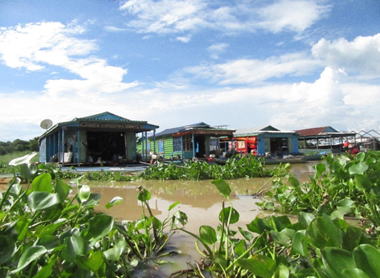
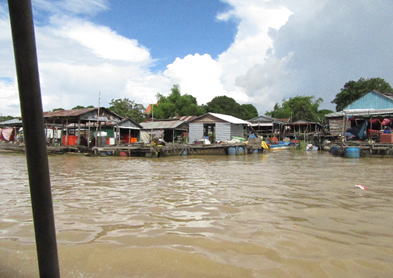
Housings in Phat Sanday Village 1 Housings in Phat Sanday
Village 2
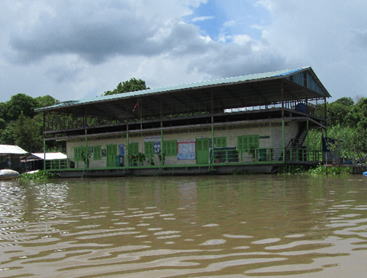
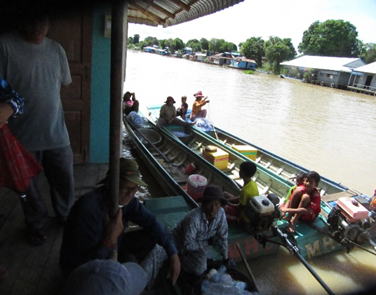
An elementary school in Phat Sanday Village Hearing to housewives fissing as a work
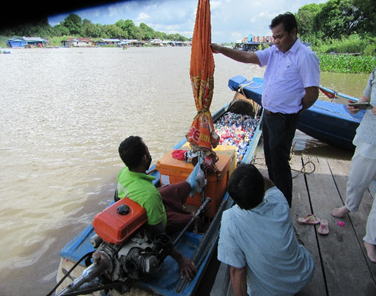
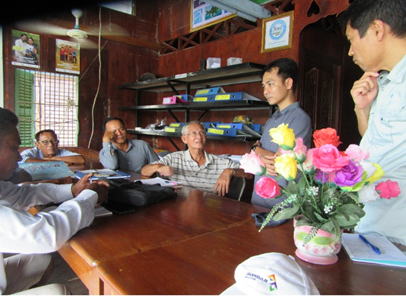
Intereview to a collector of recyclable waste Briefing to commune
members
Interview survey
We interviewed 25 households in Phat Sandy village. It turns out that the percentage of both organic waste (kitchen waste, etc.) and plastic waste that is disposed of in the lake increases during the rainy season. The ratio of storing used plastics also increases slightly during the rainy season. On the other hand, during the dry season, when land appears, the rate of burying and burning increases. In an interview with an elementary school teacher, he said that a place for plastic waste was created in the schoolyard and the collected plastic waste was burned. Some people also use PET bottles as "floats" for fishing nets. During the fishing season, the purchase price of PET bottles rises, so some families collect bottles until then. Plastic that is stored after use will eventually be thrown away. Plastic waste ends up in lakes, landfills, burning, or recycling. Open burning of plastic waste is not recommended as it generates combustion gas. Plastic is difficult to be decomposed by microorganisms and has a long lifespan when buried, and is thought to exist for hundreds of years. If you bury it in a place that is submerged during the rainy season, there is a possibility that previously buried plastic waste will end up in the water. Recycling of the used plastics seems to be the appropriate method.
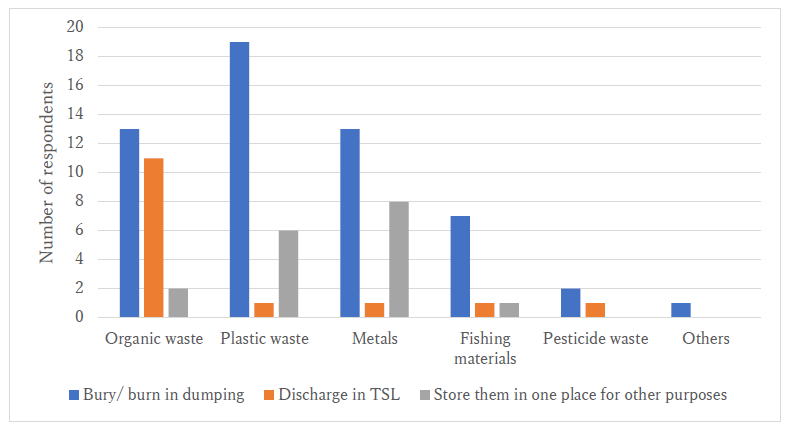
Disposal ways of the waste by category in dry season (TSL means Tonle Sap Lake)
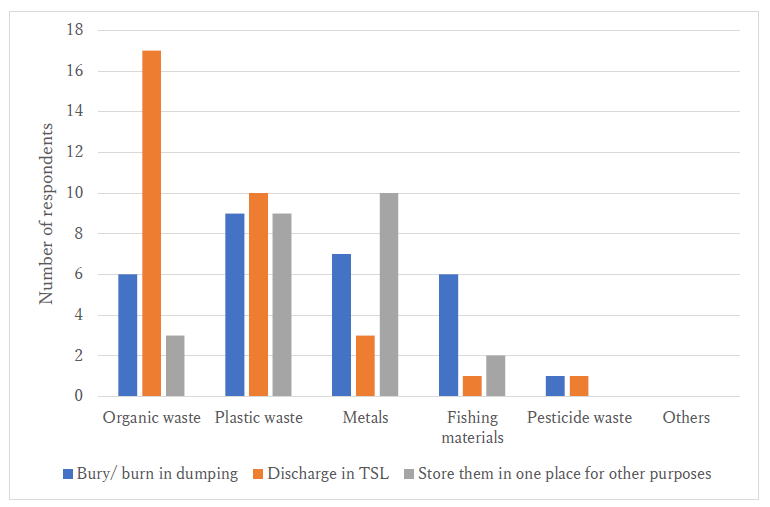
Disposal ways of the waste by category in rainy season (TSL means Tonle
Sap Lake)
Waste Audit
In September 2022, we conducted a composition survey of plastic waste. Phat Sanday Village is a commune of five villages, and we asked 11 households among them to keep the waste for a week. We prepared white and black garbage bags and asked them to put in the white bags what they recognized as plastic waste, and in the black bags they put other items without kitchen waste. After a week, the bags were collected and weighed by composition. There are many types of plastic waste, but the categories here are easy to classify: 1) plastic bottles, 2) film-like items (bags, containers, drink cups), 3) hard plastics (resin, PVC, etc.) ), 4) plastic foam.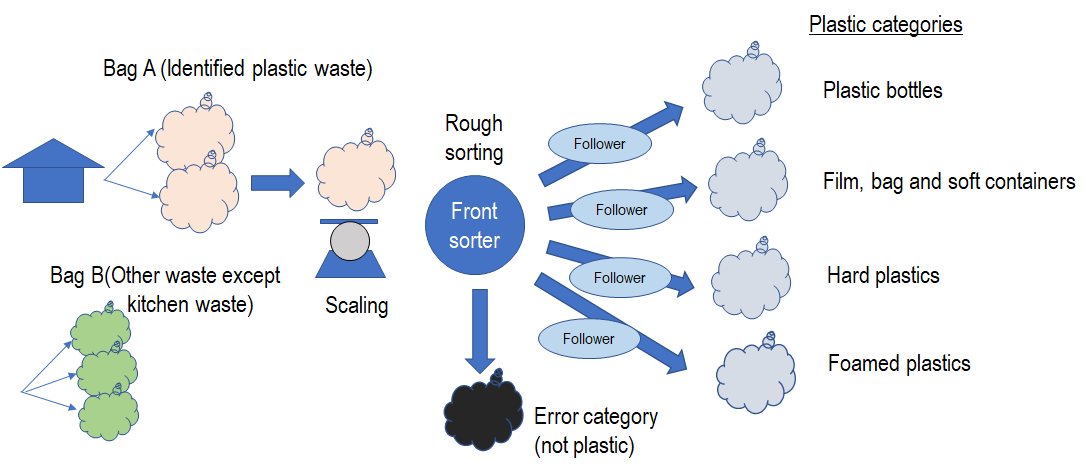
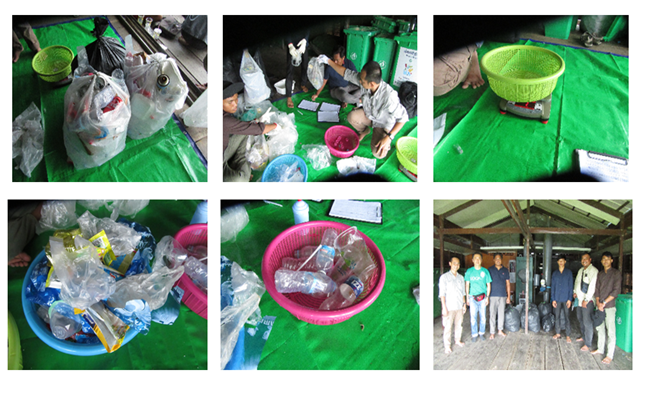
The analysis showed that the average daily plastic emissions per household was 270g, of which 135g was recyclable.
Recycling path
In Phat Sanday Village, private collectors for recyclable waste (collectors) go around the village and buy cans and PET bottles, and the waste collected is purchased by recyclable waste wholesalers (junk shop) in Chnok Tru Village. And the junk shop sell them in large quantities to large-scale consumers such as recycling plants after compressng and packing. For transportation, the junk shop transports it to the customer in a large truck, and the customer comes to pick it up. When we asked junk shop owners in Chnok Tru Village, they told us that they had customers coming from neighboring countries such as Vietnam and Thailand by large trucks, but they had no customers in Cambodia at the present. Since recyclable waste is costly to transport across borders, the purchase price is low. Therefore, plastic waste other than PET bottles has no value (has no value). According to a survey conducted in June 2022, the price at which junk shops purchased PET bottles from collectors was about US$0.50 per 100 bottles. In June 2023, I visited a junk shop in Kampong Chhnang City and asked about the price. got it. (described later)
Feasibility study
Based on the baseline survey, a simulation of separate collection of PET bottles was performed. From the survey, the amount of PET bottles generated per household (3 bottles/day) was set at participation ratio 60% according to the questionnaire survey, and the purchase price at the junk shop was set at 0.5 US dollars/100 bottles. Using Google Maps, we used Google Maps to determine the distance to pick up garbage from each house by boat, and the distance to transport the collected garbage to the junk shop in Chnok Tru village. As a result of employing collectors on an hourly basis and taking into account the consumption of gasoline for the collection boat, the money returned to the villagers was less than the money that villagers would have received if they sold PET bottles directly to a junk shop. (However, the cost of the villagers going to sell them by boat is not taken into account.) Since the villagers would be dissatisfied with this, they argued that if the whole village sorted the bottles, they would be able to collect a lot of clean PET bottles, and the junk shop would charge a high price. You will need to purchase it. It was concluded that the village representative should negotiate with a target of almost double the purchase price. However, in the end, the commune representatives decided that the proceeds would be managed by the commune and used for village events.
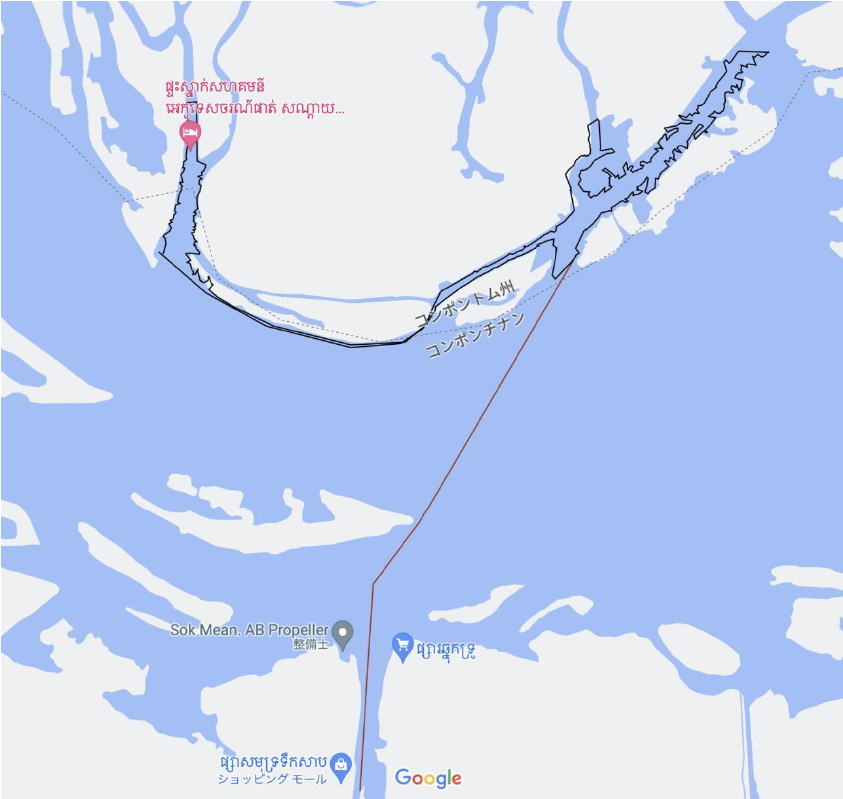
Waste collection route extracted from Google Map and transport route
of collected garbage
Education materials
It was necessary to separate and recycle PET bottles throughout the village,
and a booklet (8 pages) was created to educate and enlighten the villagers.
In terms of knowledge about plastics, we showed that plastics are made
from petroleum, and that the lifespan of plastics differs depending on
the type, but it takes 50 to 650 years for microorganisms to decompose.
The lifespan of plastics is much longer than that of humans, and when we
dump plastic waste into lakes, we shift the burden of its disposal onto
future generations. Plastic users should think about it and not throw it
into the lake. In addition, it describes manners for sorting PET bottles,
such as removing the caps, throwing away the contents, and compressing
them. We are preparing an easy-to-understand booklet with the above as
a manual for adults and inserting comics for children. It is necessary
for the next generation to have knowledge of separation and recycling from
childhood, and the goal is to have them use it as a teaching material in
elementary schools.
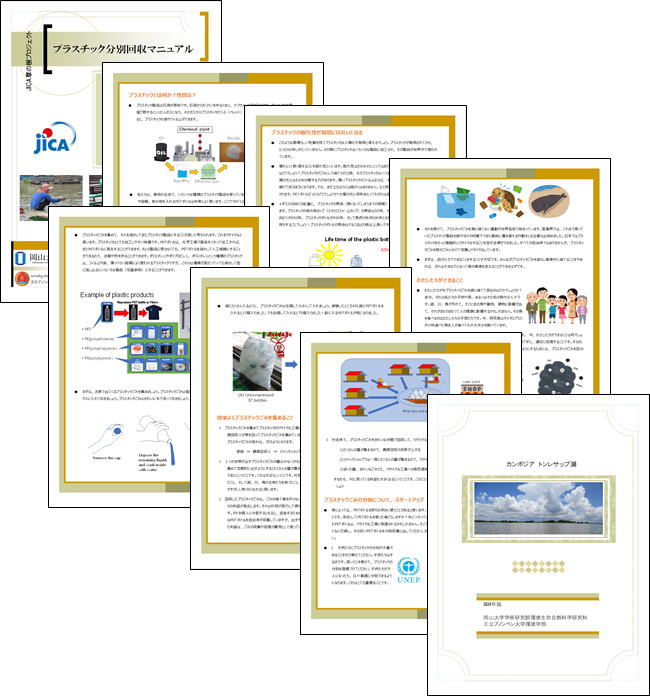
Team training
We recruited a separation promotion team that would actively promote the separation and recycling of plastics as a leader in the village. When I asked village representatives to form a team, the members included the names of familiar commune representatives. I was expecting someone with young vitality, but it turned out to be a relatively high-age team. The reason for this is that I later found out that the separation of plastic waste is an issue of concern to the village and must be addressed by the village manager. In the plan, we planned to invite the heat separation promotion team to Japan (Okayama City) and have them see the garbage separation and plastic recycling technologies that we are so familiar with. I found it very difficult to get a visa. Therefore, I gave up on training in Japan and switched to training in Cambodia. The on-site training will be held for 4 days from May 30th to June 2nd, 2023. 7 members of the separation promotion team, 2 iDE members of NGO, 3 from Okayama University, 2 from Royal University of Phnom Penh, 1 assistant from the Ministry of the Environment people participated. The content and results of the training are described below in chronological order.
[Meeting, confirmation of training objectives, introduction of NGO iDE activities]
At the venue in Kampong Chhnang City, after members, obervers and us met together at the beginning, and we confirmed the purpose of the training, introduced the activities of the NGO iDE, and explained the training program.
[Interview to junk shops]
We visited three junk shops (wholesale shops) in Kampong Chhnang City and conducted hearings on plastic recycling. It turned out that the purchase price of PET bottles is higher than the junk shop in Chnok Tul Village. I also found out that a certain store will take back the PET bottles for a higher price if the film has been removed from the bottles. On the other hand, we learned that plastic bags, etc. cannot be purchased for a price, but they will take them for free. All members of the separation promotion team enthusiastically participated in the hearing.
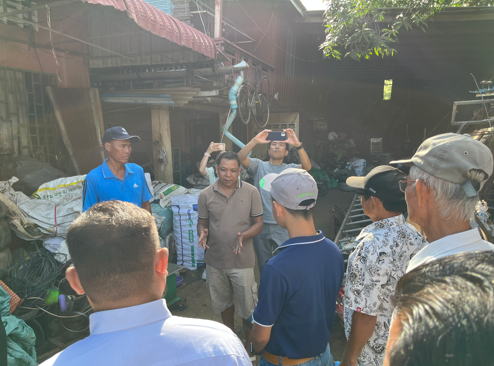
Members listening intently to the junk shop owner
[Visit to the final disposal site in Kampong Chhnang City]
We inspected the final disposal site currently in use and the newly constructed final disposal site in Kampong Chhnang City. A large amount of plastic waste was conspicuously seen at the conventional final disposal site, and it was found that the amount of waste was large. There were many scavengers who collected recyclables from the landfill site, and children also helped their parents. I was told that the city hadn't stopped scavengers from entering. Many cows were also kept in the disposal site. Recyclable plastics were collected and packed in bags or piled up to be exposed to the rain. After collecting the valuables, the scavengers set fire to the litter to burn the mostly plastic debris on the surface. When I asked why, they said it was to reduce the volume of plastic on the surface. Meanwhile, the new final disposal site had just been built and had not yet been filled. It was designed to collect wastewater and purify the oxidation site.
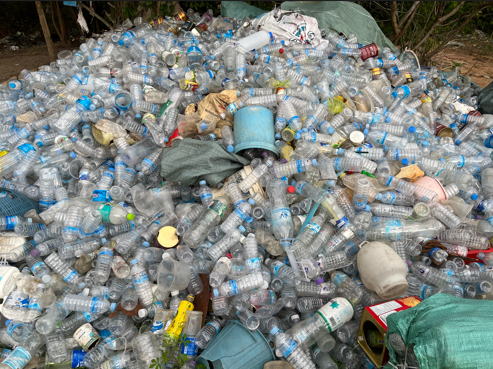
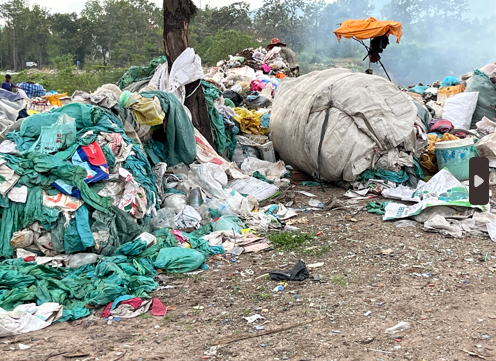
Collected PET bottles Collected plastic bags
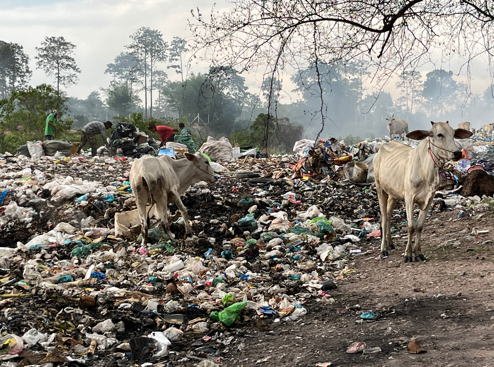
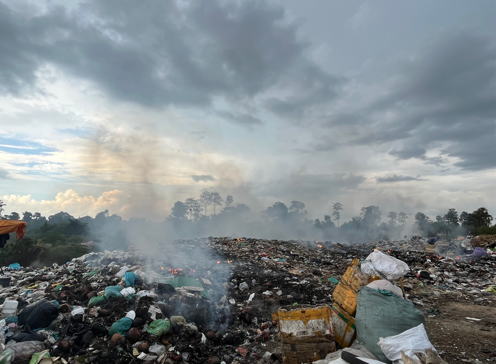
Cows finding foods Burning to reduce plastic waste
[Observation of open PET bottle collection in Loon Village, Pursat Province]
We observed PET bottle collection activities by the NGO iDE in Loon Village, Pursat Province. iDE has set up a large box for PET bottles on the boat and moored it next to the elementary school boat so that children can carry plastic from home and throw it into the box. We thought it was a perfect experiment for children's waste separation education. In addition, the large box is very conspicuous, and residents can bring plastic bottles by boat and put them in at any time. It is considered to be easy to collect for PET bottle collectors. It may be worried about that the bottles are theft by suspicious persons at night. It was a very easy-to-understand and effective attempt, and the interest of the visiting members was high.
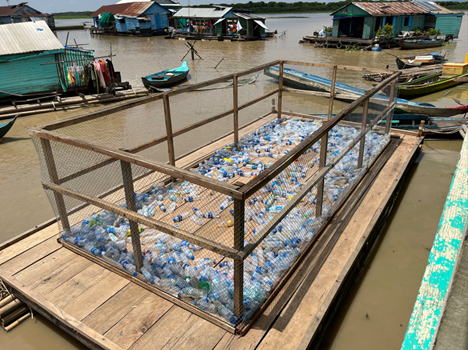
A boat for collecting PET bottles placed next to an elementary school
[Visit to plastic recycling factory]
On our way to Battambang City, we visited a plastic bag recycling factory. It seems that this factory is the only factory in Cambodia that recycles plastic bags. The treatment process is simple. After washing the collected plastic bags with water and drying them, they are placed in an electric melting furnace and melted. It was cut into pellets. By mixing different colored bags, the resulting pellets were black. A manager from Cambodia worked at a plastic recycling factory in South Korea and reproduced the technology in this factory. Since there are many plastic bags in plastics other than PET bottles, it was thought that this facility could be one of the recycling paths.
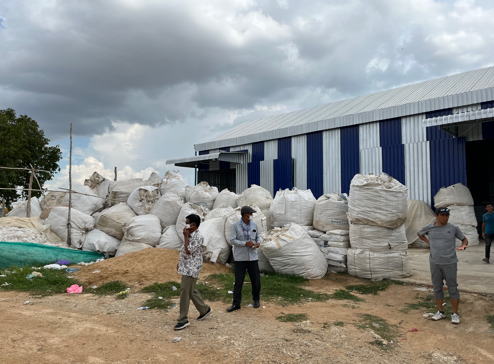
Plastic bag recycling plant
[Waste management in Battambang City and the recycling initiative]
We listened to a lecture on the city's waste management and future recycling plans from a staff member of Battambang City. The city has been focusing on biomass recycling. Currently, households do not sort garbage, but they will do so in the future.
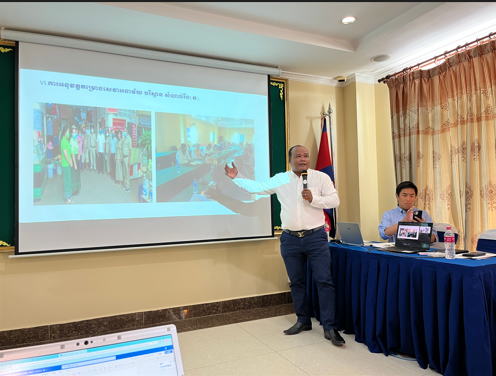
Lecture by the Director of Environment Department, BTB City
[Visiting a composting factory and a plastic waste sorting station in Battambang City]
We visited a composting plant and a plastic sorting plant adjacent to the
final disposal site in Battambang City. The city has been promoting composting
of biomass with the support of European NGOs. And the adjacent factory
sorted plastic waste and packed the plastic waste. In the city, the plastic
waste that flows from the upper reaches of the river is deposited in the
river, and the plastic waste collected at the bottom of the river is cleaned,
sorted, packed, and recycled. It seems that a considerable amount of plastic
waste is thrown into the river, and we learned that the problem of plastic
waste is serious around Lake Tonle Sap.
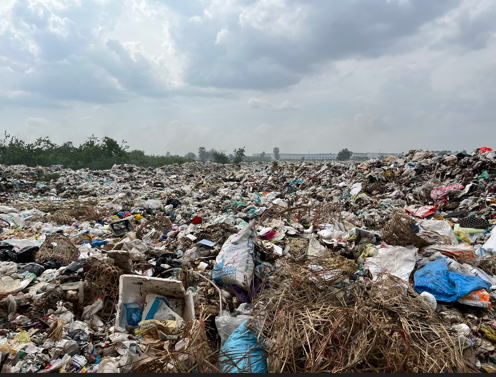
Final disposal site in Battambang City
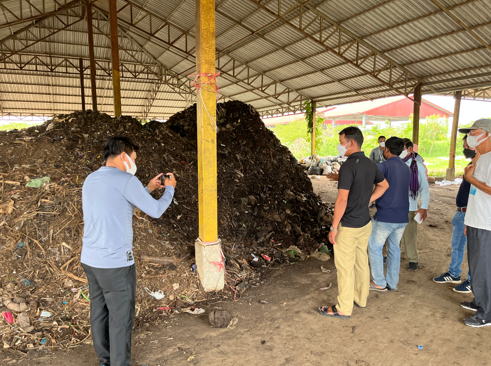
A composting yard adjacent to the landfill
[Discussion meeting on PET bottle segregting and recycling system suitable for Patsandy village]
A meeting was held at the venue in Battambang City on waste separation
and recycling strategies for Pat Sandy Village. First, a lecture was given
using an educational enlightenment booklet. This is because each member
of the separation promotion team must instruct villagers as promotion leader.
Some members said that the content of the booklet was difficult. Most of
the villagers have an educational background up to elementary school, and
some are illiterate. Indeed, it is necessary to improve the enlightenment
booklet into something more readable and simple. In addition, we got opinion
that one page flyer is also useful. We are planning to create a children's
booklet as a simple one, so we would like you to choose and use it as appropriate.
We continued to discuss about the separation and recycling system suitable
for Patsandy Village. We were planning to discuss how to collect PET bottles
and what recycling route to put them on, but the separation promotion team
focused on creating an organization for separation throughout the village.
The first priority was to create an organization to promote the separation
and recycling in Pat Sandy Village Commune. The discussion was heated,
and it was finally decided to establish an organization with one person
in charge from each village, one leader to coordinate, and two sub-leaders
to assist. We wondered that we would be able to start immediately after
deciding on the procedures for separation and recycling waste, but it seems
that the commune will only be able to handle this after the organization
has been decided. In this way, there have been times when the opinions
of the local people have diverged from what we have prepared, but each
time it becomes clear what the local people think and what they want, I
could feel the enthusiasm to work on it.
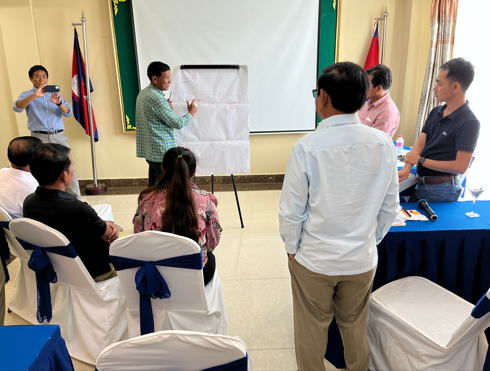
Discussion on creating an organization responsible for separation and recycling
in Patsandy Village
In this way, during the on-site training around the northern shore of Tonle Sap Lake, we interviewed junk shops, conducted garbage separation activities in the neighborhood, and visited recycling plants, municipal landfill sites, and recycling facilities. To our surprise, at the last discussion, the members of Pat Sandy Village decided to formally establish a separation and recycling organization in the village. They were able to make a decision because the separate promotion team was made up of commune representatives. I think the representatives decided to create their own plastic separation and recycling system.
Briefing sessions
In December 2022, we held an explanatory meeting for the villagers on the necessity and method of plastic waste recycling. 33 villagers participated in the event, which was held in the commune's meeting hall. The enthusiastic participants asked whether we should recycle plastic waste other than PET bottles, and asked about the PET bottles used for the fishing floats. Regarding the former, we would like to promote the recycling of plastic bags. , but replied that we would start by recycling PET bottles, which have a recycling route. As for the latter, people who use PET bottles as floats for fishing collect PET bottles in this village, and they asked if we should dispose of these bottles separately. In response to this, we answered that we would like them to use it as a float and dispose of it after use. Based on the response from the briefing session, many of the villagers thought that it was necessary to separate and recycle plastic waste, and I felt that they were interested in what kind of separation would be done.
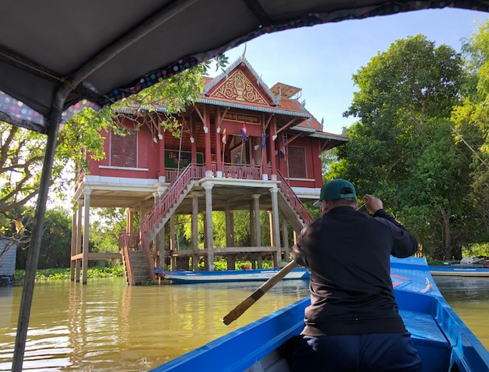
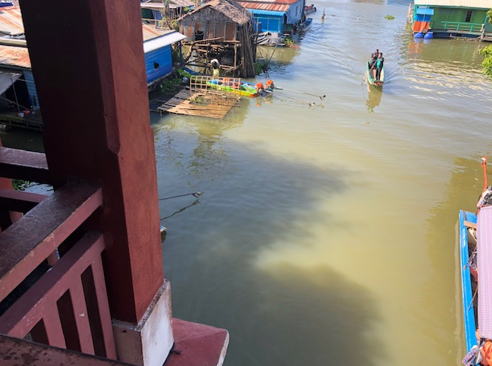
市民説明会の会場(コンミューン集会所) 雨季のためボートで集まる
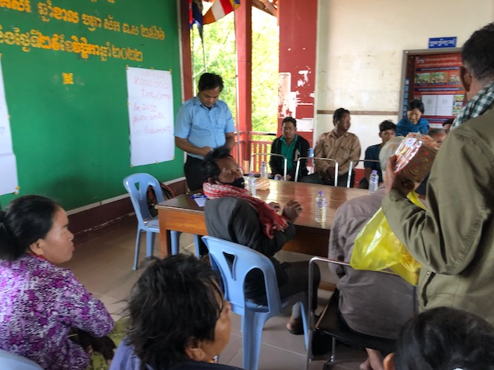
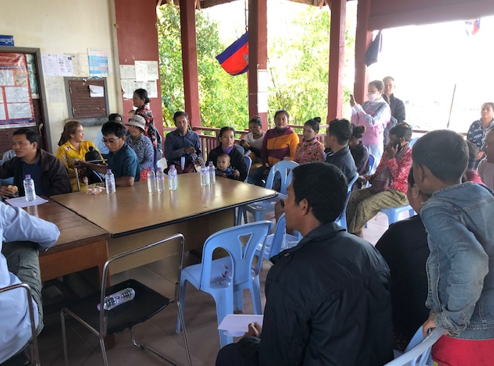
PETボトルの分別・リサイクルの説明 説明を聴く聴衆
Cleanup event
On June 3rd, unlike World Environment Day, we held a cleanup event in Phat
Sunday Village, and about 130 villagers, including many elementary school
students, participated. We had them gather in front of the commune's meeting
hall in the morning, and after introducing them to the PET bottle separation
and recycling project that we were going to promote, we all cleaned up
the plastic waste. A lot of bags which we put garbage in in a short time
gathered. We sorted them out, put the PET bottles to good use..
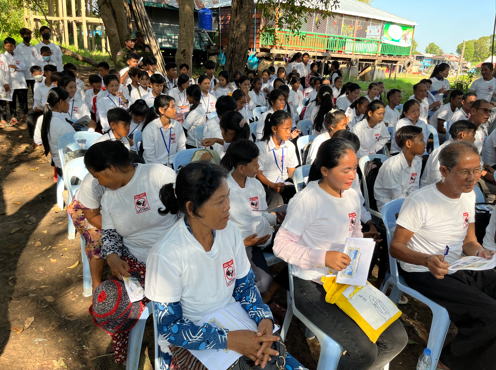
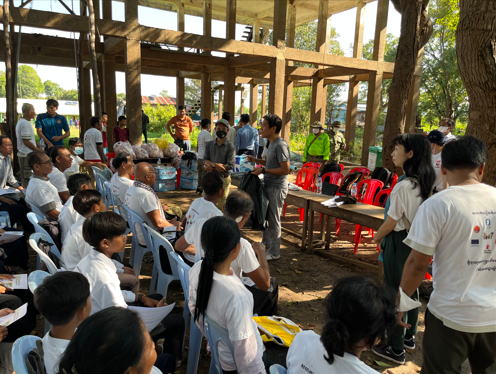
Villeger's participation in cleanup events Participants listening
to explanation
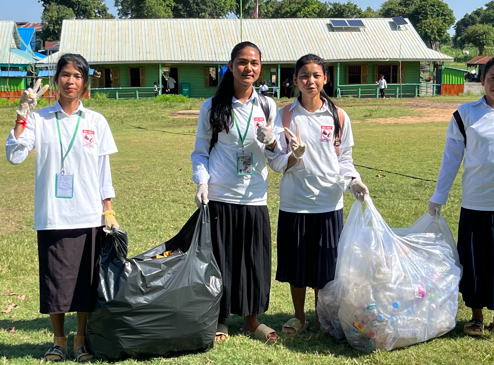
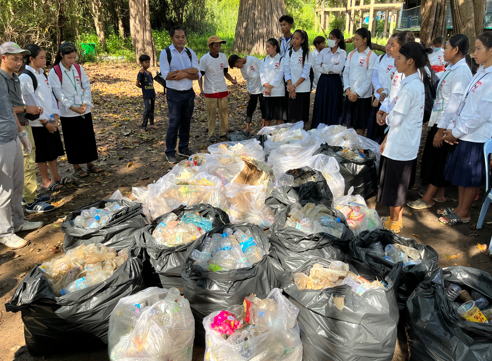
Students collecting garbage Cooperation in garbage sorting
work
About the future
Pat Sandy Village plans to build an organization for separation and recycling PET bottles. We will be able to provide further support at the stage that the established organization determines specific separation and recycling procedures . It is expected that the separation action will start by the end of August. In December we would like to monitor the progress of the separatin and recycling and also conduct a interview survey about changes in villagers' awareness.